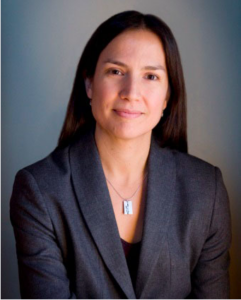44 Nadine Caron
Dr. Nadine Caron |
 |
Time period:1993-present Subject:Medicine |
|
Biography:Dr. Nadine Caron is a surgical oncologist in Prince George, BC, and an associate professor in the Department of Surgery, Faculty of Medicine at the University of British Columbia North. She also teaches for the Center for American Indian Health at the Bloomberg School of Public Health, Johns Hopkins University. Further, she is the Co-Director of the UBC Centre for Excellence in Indigenous Health at UBC’s School of Population and Public Health. Along with her Medical Doctorate, Caron also has a Masters in Public Health from Harvard University and was awarded UBC’s Top Student Award. Dr. Caron is Anishnawbe from Sagmok First Nation. |
|
Summary of their contributions:Dr. Nadine Caron’s work spans many fields, including work as a medical doctor, a professor, and a leader in the Northern Biobank Initiative. At the forefront of all of her work is the goal to have the medical system support and represent First Nations communities. For example, her Northern Biobank Initiative is aimed at giving more equitable access to genomic research into diseases such as colorectal, breast, and thyroid cancer for northern British Columbians, including members of rural, remote First Nations communities. Another example of equity within her work is in her role as co-director for the Centre for Excellence in Indigenous Health which was created to advance Indigenous people’s health through education, innovative thinking, research, and traditional practice. Nadine also works as a medical doctor in rural BC, which in itself is a way to provide equitable care for Indigenous communities, as there is a shortage of physicians in rural BC.
|
|
Integration with the BC Secondary Science Curriculum:Caron’s work aligns with several aspects of the BC Secondary Science curricula, in the way of the content learning standards, and curricular competencies. Nadine’s work as a physician most closely aligns with content learning standards from Science 8 Biology and Anatomy and Physiology 12. In Science 8 Biology, students learn about the relationship of microorganisms with living things and how this applies to medicine and public health. In Anatomy and Physiology 12, students focus entirely on the anatomy and physiology of humans- the basis of knowledge for a physician. As an advocate for rural Indigenous population in the BC healthcare system through several positions, Dr. Caron’s work could serve as an example for several curricular competencies throughout high-school level sciences, including but not limited to:
Dr. Caron’s work both as a physician and in her various other academic public health pursuits, serves as a prime example of incorporating equitable practices into one’s profession. |
|
References:A step in the right direction: Fighting infectious diseases in developing countries is difficult owing to limited financial resources. many pharmaceutical companies have programmes that provide much needed medicines, but more can be done. (2010). Nature Reviews. Microbiology, 8(4), 244. About. UBC Centre for Excellence in Indigenous Health 2023. (2023, July 6). https://health.indigenous.ubc.ca/about/ CEIH staff. UBC Centre for Excellence in Indigenous Health 2023. (2023, September 14). https://health.indigenous.ubc.ca/about/ceih-staff/ Curriculum. Building Student Success – B.C. (n.d.). https://curriculum.gov.bc.ca/curriculum
|
|

